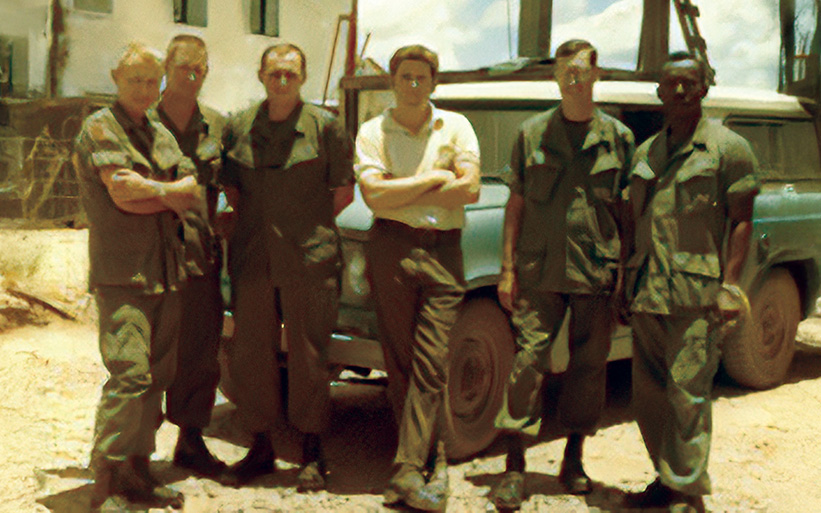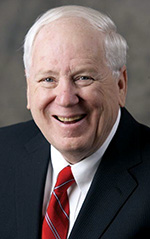The Tết Offensive: Six Hours That Transformed America
A career diplomat reflects on a pivotal moment in the fraught Vietnam War era.
BY KENNETH M. QUINN

In the second half of 1970, FSO Ken Quinn (center, white shirt) was the senior adviser in Duc Ton district of Sa Dec province in South Vietnam as part of MACV/CORDS Advisory Team #65. In that position, he led a 13-person U.S. Army team, participating in more than 100 hours of helicopter combat operations, becoming the only civilian and only FSO to earn the Army Air Medal. Pictured here with Quinn are (from left) team members Sgt. Norbert Stynski, Sgt. John Hoover, Capt. Paul Kalowski, Lt. Jim Connell, and Sgt. James Smith.
Courtesy of Kenneth Quinn
January 1968 had not started in an apocalyptic fashion. The triumphal sense that America was a force for good and capable of accomplishing almost anything it put its mind to—having begun with victory in World War II and, inspired by President John F. Kennedy, taken us to space and set us en route to the moon—still pervaded the country. As a result, President Lyndon Johnson seemed securely ensconced in the White House as he prepared to launch his reelection campaign. While there were some disquieting signs that anti-war elements were causing unrest on college campuses—something I had witnessed as an instructor at the University of Maryland—as the year began, the opinion polls still showed a firm majority supporting the war effort in Vietnam.
Saturday, Jan. 27, 1968, was the first day of Tết Mậu Thân, the Vietnamese New Year celebration that marked the beginning of the Year of the Monkey. As the media ran stories about the informal military cease-fire that was going into effect across South Vietnam, I had just begun long-term Vietnamese language training and was immersed in learning phrases to extend wishes for good health and prosperity.
I was a brand-new Foreign Service officer from Dubuque, Iowa, and my visions of diplomatic soirees in chandeliered ballrooms in Paris or Vienna had been dashed when the personnel mavens at Foggy Bottom assigned me—a single, unmarried, 25-year-old draft-eligible male—to 10 months of Vietnamese language training followed by a tour as a pacification adviser helping win the “hearts and minds.” Although whatever that exactly entailed was not yet clear, the scheduled training segment at the Special Warfare Training School at Fort Bragg conjured up ominous possibilities.
The Vietnam Training Center, or VTC as everyone called it, was in a drab, charmless basement of the Arlington Towers apartment complex in Rosslyn, just across the Key Bridge from Georgetown. For six hours a day, we would assemble in small groups in windowless rooms endeavoring to mimic the seemingly impossible (to me) sing-song tonal language that was Vietnamese.
It was the culmination of seven years of political upheaval, all of which had begun on that night in January 1968, when those 20 Việt Cộng blew their way into the U.S. embassy compound.
I could not have realized that this assignment would give me a front-row seat to one of the most tumultuous periods in American politics since the Civil War, one that began 57 years ago, on Tuesday, Jan. 30, 1968.
Ten months later, just before Thanksgiving, as I boarded a plane to fly to Saigon and start my assignment in the Mekong Delta, our politics, race relations, the Vietnam War effort, and America’s triumphal spirit would all be seemingly forever changed.
Assault on the Embassy
It all began when, breaking the traditional Tết truce, the North Vietnamese Army and the Việt Cộng opened a surprise nationwide attack on Jan. 30. The images of the fighting, which affected every major population center in South Vietnam including the capital city of Saigon, flowed almost instantly into millions of homes across America via television, sent by a new generation of skeptical, young correspondents, reporting firsthand from the scenes of battle.
The fighting was intense, and American casualties were the highest ever. Among them were Foreign Service personnel, including Robert Little, with whom I had been practicing my Vietnamese tones just a few weeks earlier. Pulled from language training and sent early to address refugee issues, Little had been captured by a North Vietnamese team and summarily executed. The account of his death brought home the reality of the danger of our assignment. From then on, the main topic of our discussions during the breaks between hourly language classes was which handgun to buy to take with you and the ballistic capabilities of various types of ammunition.
The most significant event of the Tết Offensive and, in retrospect, of the entire Vietnam War, occurred at 2:45 a.m. Saigon time on Jan. 31. It was then that a 20-man Việt Cộng “sapper team” blew a hole in the outer wall of the brand-new U.S. embassy compound and then rushed inside to try to storm the chancery, where the ambassador’s office was located. Frustrated by the ballistic doors and unable to enter the main office building, the insurgents nonetheless marauded about the grounds in search of targets.
Several of the attackers gained access to an annex building where a senior official, George “Jake” Jacobson, one of the few individuals living on the compound (and who four years later would be my boss), was trapped without a weapon on the top floor. As the guerrillas made their way up the stairs inside the building, Jake opened the window and shouted for help. A Marine Security Guard threw his .45 caliber pistol up to Jacobson, who, according to the reports eventually making their way back to the Vietnam Training Center in Arlington, spun around and shot his would-be assassin in the face when he entered the room.
U.S. Superiority Takes a Hit
In tactical terms, the assault on the embassy was judged a failure. By 9:30 a.m., just six hours later, the episode had concluded. All of the Việt Cộng were dead, their bodies strewn around the embassy grounds. To demonstrate we had reestablished control, Ambassador Ellsworth Bunker came to inspect the situation with a coterie of Western journalists, recording every image and then sending them back by wire service and video reports that would be seen in every remote corner of America.
In strategic terms, however, the penetration of the U.S. diplomatic compound, the symbolic heart of American power and authority, was the most traumatic and devastating aspect of Hanoi’s monthlong countrywide offensive. The images and television reports of it undermined the confidence of the American people in the conduct of the war and began the erosion of the country’s will to prevail in the conflict.
The perception that even with 500,000 U.S. military personnel in the country, we were unable to protect the embassy, the vital center of our operations, spread across America. Even for military hawks, the view began to take hold that something was profoundly flawed in the war effort. Concerns multiplied that the president and General William Westmoreland had badly misled the American people and foolishly ensnarled us in an unwinnable conflict.
The images of the fighting flowed almost instantly into millions of homes across America via television.
The visit to Vietnam of avuncular CBS evening news anchor Walter Cronkite in February, and his audible on-air sigh during his commentary upon return, expressing doubt that victory was possible, was the dagger to the heart of President Johnson’s reelection bid. Approval ratings of the war effort dropped below 50 percent in just one month; and, as a result, insurgent Democratic candidate Senator Eugene McCarthy of Minnesota came close to pulling an upset over LBJ in the New Hampshire primary in mid-February.
Johnson, who had produced a remarkable array of legislative accomplishments in civil and voting rights following the JFK assassination, had in effect presided over what would be the final year of America’s post–World War II triumphalism. It had been an ever-ascending period of U.S. global leadership and dominance, which made New York the commercial capital of the world, made Washington the epicenter of global military power and diplomatic influence, and caused America to be seen as the ubiquitous bulwark against communism.
Then, in a stunning array of increasingly traumatic political tremors and tragedies, America’s triumphal position came undone. Violent paroxysms tore apart the country’s political fabric and intensified opposition to the Vietnam War. In late March, as the Wisconsin primary approached, Johnson, trailing badly in the polls, stunned the country by withdrawing from the presidential race.
Political Unraveling
That was followed just a few days later, on April 4, by the assassination of Dr. Martin Luther King Jr. I can still vividly recall standing transfixed outside our Arlington training center as huge plumes of black smoke rose out of the burning national capital city. That weekend, when the fires had been put out and order restored by units of the 82nd Airborne flown in from North Carolina, I drove into D.C. and saw the results of the rage that the murder of Dr. King had unleashed. The sights of burned buildings and helmeted soldiers carrying rifles with fixed bayonets on street corners remain with me to this day.
It was then that Robert Kennedy stepped to center stage. Carrying the mantle of Camelot, he seemed to offer the chance to restore the ascendancy of the New Frontier and the justice his brother, Jack, had pledged to African Americans. It seemed that the triumphalism of post–World War II America that JFK had symbolized could be restored. If there was any hope of undoing the damage to the body politic of the past four months, Bobby Kennedy was that possibility.
And then, in a hotel ballroom, that last chance for redemption was shattered on June 5 by an assassin’s bullet that took Bobby Kennedy’s life. Watching the hearse carry his body across Memorial Bridge en route to Arlington Cemetery, I recall feeling an incredible sense of depression about the direction of the country.
The perception that even with 500,000 U.S. military personnel in the country, we were unable to protect the embassy, spread across America.
The anti-war protests and demonstrations in inner cities that multiplied across the country, followed by the turmoil at the Democratic National Convention in Chicago that produced harsh responses by law enforcement, left the political process convulsed. The impact of this yearlong political unraveling became evident with the election of Richard Nixon later that year and the beginning of Vietnamization—turning the war effort over to South Vietnamese forces. It soon became clear that the U.S. was no longer trying to win the war, only to find a way out.
By the time I arrived in Vietnam in late November 1968, assigned as part of the Military Assistance Command, Vietnam (MACV) in the Mekong Delta, I witnessed the rapid spread through the U.S. military of the attitude that “I don’t want to be the last person to die in Vietnam.” The contagion eroded discipline and morale, especially among draftees.
While Nixon’s election could be seen as temporarily providing a respite to the political turmoil that had, like an Iowa tornado, swirled the nation uncontrollably, events over the next few years continued to keep tensions high. The killings at Kent State, the Cambodian incursion, and eventually Watergate (which I observed as a member of Henry Kissinger’s National Security Council staff) left America exhausted, divided, and without the will to continue the Vietnam struggle.
The Final Blow
Seven years later, the ignominious disgrace of the American ambassador fleeing the advancing North Vietnamese Army on April 29, 1975, from the roof of an embassy building in a helicopter, dealt the final blow to American triumphalism. It was the culmination of seven years of political upheaval, all of which had begun on that night in January 1968, when those 20 Việt Cộng blew their way into the U.S. embassy compound.
In an apocryphal reflection on the denouement of America’s decade in Vietnam, the British counterinsurgency expert Sir Robert Thompson was reported to have said: “In Indochina the Americans used the most powerful weapon known to humankind. The most intriguing aspect is that they used it against themselves.”
He was referring to television, which in his view had contributed significantly to undercutting the will of the American people and thus led to our defeat in Vietnam. Despite U.S. military superiority in every way, that power had apparently been neutralized by the images, including those of dead Việt Cộng sappers inside the embassy compound, transmitted almost daily into every American home.
America’s infallibity could be offset. A divided America could be defeated.
When sharing or linking to FSJ articles online, which we welcome and encourage, please be sure to cite the magazine (The Foreign Service Journal) and the month and year of publication. Please check the permissions page for further details.
Read More...
- “From Whitehouse to the White House” by Kenneth M. Quinn, The Foreign Service Journal, April 2015
- “Viet Cong Attack on Embassy Saigon, 1968” by Allan Wendt, The Foreign Service Journal, April 2015
- “Vietnam 50 years later: Former US ambassador to Cambodia looks back in ISU lecture,” Leylah Moreno, Iowa State Daily, March 2025




